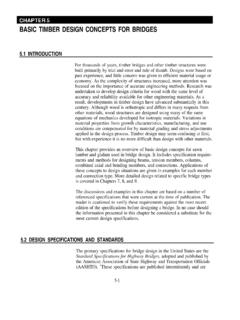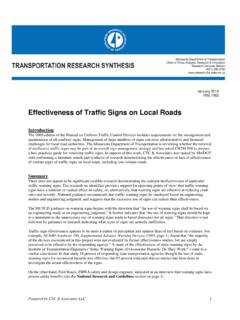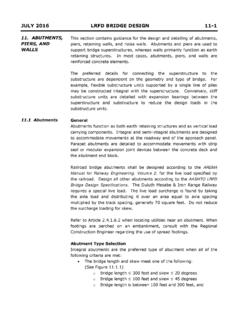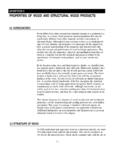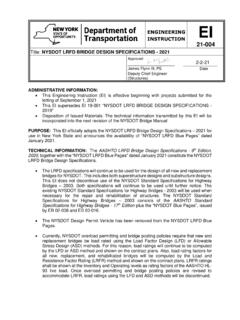Transcription of State Aid Manual
1 May 2015. State Aid Manual State Aid for Local Transportation Minnesota Department of Transportation table of Contents table of Contents Chapter 1 Introduction .. 5. I. Overview .. 5. II. Mission Statement .. 5. III. Program Goals .. 5. IV. Key Program Concepts .. 5. V. Roles and Responsibilities .. 6. VI. Rules Governing State Aid .. 7. VII. Variances to State Aid 7. Chapter 2 Municipal State Aid Streets .. 10. I. Overview .. 10. II. Municipal Screening Board .. 10. III. Designations Additions, Revisions and Revocations .. 10. IV. Allocations .. 11. V. Needs .. 12. Chapter 3 County State Aid Highways .. 14. I. Overview .. 14. II. County Screening Board .. 14. III. Designations-Additions, Revisions and 14. IV. Allocations .. 15. V. Needs .. 16. Chapter 4 Funding for Local Programs .. 18. I. Overview .. 18. II. Local Bridge Replacement Program.
2 18. III. Local Road Improvement Program .. 32. IV. Safe Routes to School .. 35. V. State Programs .. 36. VI. Federal Funding .. 39. Chapter 5 Project Delivery .. 45. I. Overview .. 45. May 2015 State Aid for Local Transportation Manual Page 2 of 226. table of Contents Chapter Environmental and Design Studies .. 46. I. Overview .. 46. II. Project Development Process .. 47. III. Location Study .. 51. IV. Public Involvement .. 52. V. Agency 54. VI. Social, Economic and Environmental Study .. 55. VII. Design Study .. 70. Chapter Right of Way .. 72. I. Overview .. 72. II. Pre-Acquisition .. 75. III. Acquisition .. 82. IV. Right of Way Certification Requirements .. 87. Chapter Agreements .. 90. I. Overview .. 90. II. Federal Agreements between the Minnesota Department of Transportation and Federal Highway Administration Legal 90. III. Minnesota Department of Transportation's Role.
3 92. IV. Federal Aid Agreements between the Minnesota Department of Transportation and other Project Partners .. 92. V. Other types of Agreements written between Minnesota Department of Transportation and Project 102. VI. Payment Request and Retainage for Federally Funded Agreements .. 104. VII. Amendments .. 105. VIII. Agreement Finals .. 105. IX. Consultant Selection .. 106. X. Project Sponsors and Delegated Oversight for Federally Funded Projects .. 107. Chapter Plans and Proposals .. 109. I. Overview .. 109. II. Basic Plan 109. III. Design Standards .. 117. May 2015 State Aid for Local Transportation Manual Page 3 of 226. table of Contents IV. Variances and Design Exceptions .. 120. V. Plan Approval .. 120. VI. Eligibility .. 125. VII. Specific Plan Requirements .. 126. VIII. Other Project Documents .. 143. Chapter Drainage .. 156. I. Overview.
4 156. II. Storm Sewer Construction .. 156. III. Agricultural Drainage .. 160. IV. Stream Flow Investigation .. 161. V. Permits for Construction of Bridges, Channel Changes and fill into 161. Chapter 6 Construction .. 170. I. Overview .. 170. II. Documentation and 175. III. Materials .. 191. IV. Contract Time and Changes .. 197. V. Subletting and Labor .. 204. VI. Payment Provisions .. 209. Chapter 7 Bridge Maintenance .. 215. I. Bridge Inspection and 215. II. Rating Local Bridges .. 217. III. Restricting Traffic on State Aid Routes .. 217. Chapter 8 Finance .. 218. I. Overview .. 218. Abbreviations .. 219. Revisions .. 224. May 2015 State Aid for Local Transportation Manual Page 4 of 226. Chapter 1 Introduction, I. Overview, II. Mission Statement, III. Program Goals, IV. Key Program Concepts Chapter 1 Introduction I. Overview State Aid for Local Transportation (SALT) was established to administer the County State Aid Highway (CSAH) and Municipal State Aids Street (MSAS) portions of the Highway User Tax Distribution Fund (HUTDF) along with federal aid highway dollars and bond funds.
5 The division also serves as the liaison between the Minnesota Department of Transportation (MnDOT) and the County and City Engineers through their Engineering associations. The strong supportive relationship between local governments and MnDOT is a key to the success of the State aid system. II. Mission Statement The purpose of the State aid program is to provide resources. Resources are mainly monetary, but also include services of the State Aid Division staff and research from the Local Road Research Board (LRRB), for example. Resources are provided from the HUTDF, which is the location for funds collected by the State according to the constitution and law, and then apportioned among the counties and cities. The apportioned funds assist counties and cities with their construction and maintenance of community interest highway and streets on the State aid system.
6 The apportioned funds do not provide all of the resources required for the support of the State aid system, but assistance is provided because these routes function as an integrated network and provide more than only local access. III. Program Goals The goals of the State aid program are to provide users of secondary highways and streets with: Safe highways and streets Adequate mobility and structural capacity on highways and streets; and An integrated transportation network IV. Key Program Concepts Highways and streets of community interest are those highways and streets that function as an May 2015 State Aid for Local Transportation Manual Page 5 of 226. Chapter 1 Introduction, IV. Key Program Concepts, V. Roles and Responsibilities integrated network and provide more than only local access. Secondary highways and streets are these routes of community interest that are not on the Trunk Highway (TH) system.
7 A highway or street of a community interest may be selected for the State aid system if it: Is projected to carry a relatively heavier traffic volume or is functionally classified as collector or arterial. Connects towns, communities, shipping points and markets within a county or in adjacent counties; provides access to rural churches, schools, community meeting halls, industrial areas, State institutions and recreational areas; serves as a principle rural mail route and school bus route; or connects the points of major traffic interest, parks, parkways or recreational areas within a urban municipality. Provides an integrated and coordinated highway and street system affording, within practical limits, a State aid highway network consistent with projected traffic demands. The function of a road may change over time requiring periodic revisions to the State aid highway and street network.
8 State aid funds are the funds collected by the State according to the constitution and law, distributed from the HUTDF, apportioned among the counties and cities, and used by the counties and cities for aid in the construction, improvement and maintenance of CSAH and MSAS routes. The Needs component of the distribution formula estimates the relative cost to build county highways or build and maintain city streets designed as State aid routes. Both CSAH and MSAS systems utilize Needs as a portion of their funding formula. For the specifics of the formulas refer to Chapter 2 Municipal State Aids Streets or Chapter 3 County State Aid Highways. V. Roles and Responsibilities The State Aid Division, along with the eight district offices and several functional area specialists, has the following roles and responsibilities within respect to the State aid program.
9 Supervises the distribution of county and municipal State aid highway funds, federal funds and bond funds to counties and cities. Authorizes grants for bridge construction from the Minnesota State Transportation Fund. Helps coordinate local federal projects May 2015 State Aid for Local Transportation Manual Page 6 of 226. Chapter 1 Introduction, V. Roles and Responsibilities, VI. Rules Governing State Aid, VII. Variances to State Aid Rules Provides technical assistance in the design, construction and maintenance of the county and municipal State aid and federal aid highway and street systems. Promulgates rules and procedures for management of the State aid system. VI. Rules Governing State Aid The primary authority for the Commissioner of the Transportation to promulgate rules affecting the State aid system comes from Minnesota Statutes Minnesota Rules 8820 are made and promulgated by the Commissioner of Transportation acting with advice of a Rules Committee composed of nine members selected by the county boards acting through the officers of the statewide association of county commissioners and twelve members selected by the governing bodies of cities acting through the officers of the statewide associate of municipal officials.
10 In the event that agreement cannot be reached on any rules, the Commissioner's determination shall be final. The rules shall be printed and copies forwarded to the County and City Engineers. For the purposes of this section, the exempt process for adopting rules established in Minnesota Statutes may be used. These rules have force of law. VII. Variances to State Aid Rules In this section: A. General Requirements B. administrative Variance Approval A. General Requirement 1. Where a local unit of government has determined that a variance from Minnesota Rules 8820 for State Aid Operations Rules is justified, they shall submit a written request in the form of a resolution, passed by the pertinent political subdivision, to the Commissioner of MnDOT. As required in State Aid Operations Rules, Minnesota Rules the resolution shall identify the project by location and termini shall cite the specific rule or standard from which the variance is requested and describe the modification proposed.
